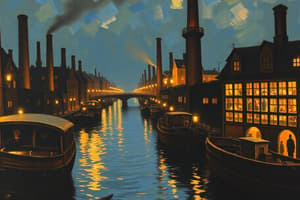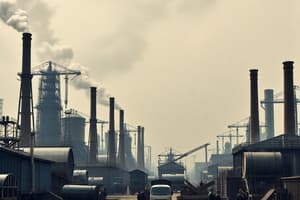Podcast
Questions and Answers
What was one of the primary driving forces behind the Industrial Revolution?
What was one of the primary driving forces behind the Industrial Revolution?
- The invention of the steam engine (correct)
- The rise of artistic movements
- The increase in agricultural production
- The expansion of global trade routes
Which of the following factors contributed to the emergence of the Industrial Revolution in England?
Which of the following factors contributed to the emergence of the Industrial Revolution in England?
- Availability of coal and iron (correct)
- The decline of urban centers
- Abundant agricultural land
- A focus on artisanal craftsmanship
How did the Industrial Revolution affect the population in Europe?
How did the Industrial Revolution affect the population in Europe?
- It led to a significant decline in population
- It resulted in a dramatic population growth (correct)
- It caused widespread emigration to rural areas
- It created a balanced demographic distribution
What significant societal change occurred due to the Industrial Revolution?
What significant societal change occurred due to the Industrial Revolution?
What was a key characteristic of the economies before the Industrial Revolution?
What was a key characteristic of the economies before the Industrial Revolution?
What social movement emerged as a response to the conditions during the Industrial Revolution?
What social movement emerged as a response to the conditions during the Industrial Revolution?
Which term describes the level of change brought about by the Industrial Revolution?
Which term describes the level of change brought about by the Industrial Revolution?
What is one of the primary impacts of the innovations introduced during the Industrial Revolution?
What is one of the primary impacts of the innovations introduced during the Industrial Revolution?
What farming technique contributes to increased food production?
What farming technique contributes to increased food production?
Which factor played a significant role in promoting industrialization during the Industrial Revolution?
Which factor played a significant role in promoting industrialization during the Industrial Revolution?
What was one consequence of the Industrial Revolution regarding the workforce?
What was one consequence of the Industrial Revolution regarding the workforce?
What characterized the living conditions in cities during the Industrial Revolution?
What characterized the living conditions in cities during the Industrial Revolution?
What was a negative effect of increased machine production during the Industrial Revolution?
What was a negative effect of increased machine production during the Industrial Revolution?
What shift occurred in society from 1750 to 1900 during the Industrial Revolution?
What shift occurred in society from 1750 to 1900 during the Industrial Revolution?
Why did entrepreneurs become significant during the Industrial Revolution?
Why did entrepreneurs become significant during the Industrial Revolution?
What was the typical work week for factory employees during the Industrial Revolution?
What was the typical work week for factory employees during the Industrial Revolution?
What was one outcome of the development of transport during the Industrial Revolution?
What was one outcome of the development of transport during the Industrial Revolution?
Which statement reflects the change in wealth distribution by 1900?
Which statement reflects the change in wealth distribution by 1900?
Study Notes
Overview of the Industrial Revolution
- A significant transition from agrarian and handicraft economies to industrial and machine manufacturing.
- Originated in Great Britain in the late 18th century and spread to Europe and the United States by the mid-19th and early 20th centuries.
- Characterized by radical economic, social, and technological transformations.
Key Innovations
- The steam engine was crucial for industrial development, relying on coal and iron as primary fuels.
- Advances in farming like crop rotation and selective breeding led to increased food production, which supported population growth.
Causes of the Industrial Revolution
- Government Policy: Liberalization of industrial policies facilitated industrial growth.
- Inventions & Technologies: New technologies transformed power sources, manufacturing processes, communication, and transportation.
- Entrepreneurial Ambitions: Entrepreneurs were pivotal in driving innovations that initiated the Industrial Revolution.
- Demand for Goods & Services: Shift from hand-crafted products in home businesses to machine-aided production in factories increased efficiency and availability.
Consequences of the Industrial Revolution
- Wealth Distribution: Broader distribution of wealth and increased international trade.
- Migration Patterns: Mass migration from rural areas to urban centers seeking factory jobs, leading to overcrowded and unhealthy living conditions.
- Increased Production: Machines enabled higher production rates, resulting in cheaper goods and greater wealth for factory owners.
- Long Working Hours: Factory workers, including men, women, and children, faced long hours (14 to 16 hours a day, six days a week) often under dangerous conditions.
Negative Effects
- Industrial pollution and urban crowding remain ongoing issues linked to industrialization.
- The process of industrialization introduced significant social challenges, including unsafe working conditions and low wages.
Economic Shift from 1750 to 1900
- 1750: Predominantly agrarian economies with concentrated wealth and limited inter-regional trade, hindered by poor transportation.
- 1900: Transition to manufacturing economies, increased wealth distribution, and expansion of the middle class. Growth of the factory system hired large numbers, including women and children, under challenging labor conditions.
- Development of transport systems, like steam locomotives, improved connectivity and commerce.
Studying That Suits You
Use AI to generate personalized quizzes and flashcards to suit your learning preferences.
Description
Explore the transformative period known as the Industrial Revolution, which began in Great Britain in the late 18th century. This quiz covers the significant economic, social, cultural, and environmental changes that reshaped societies worldwide. Test your knowledge on this pivotal moment in human history.






